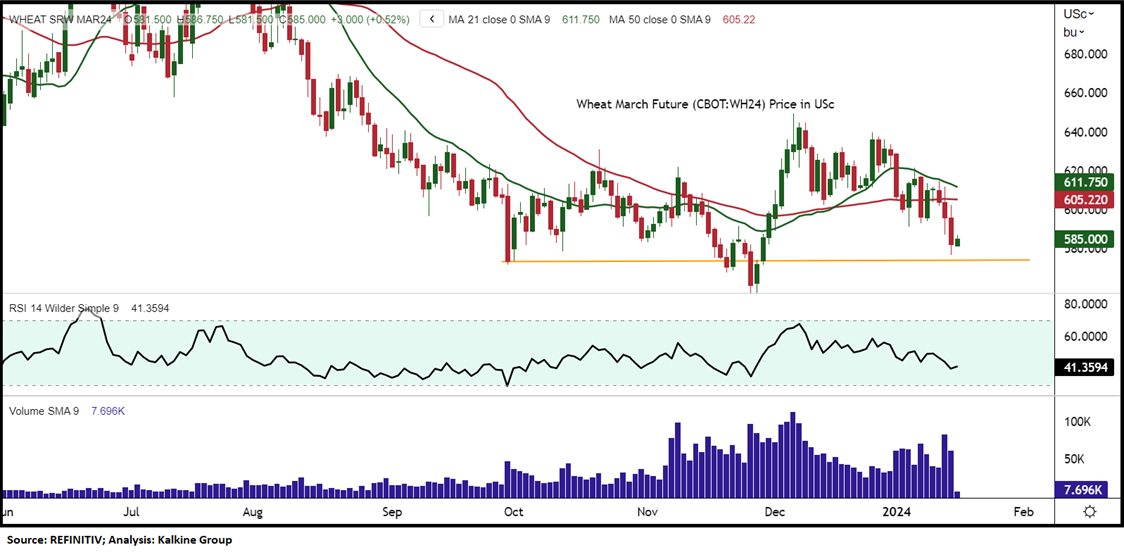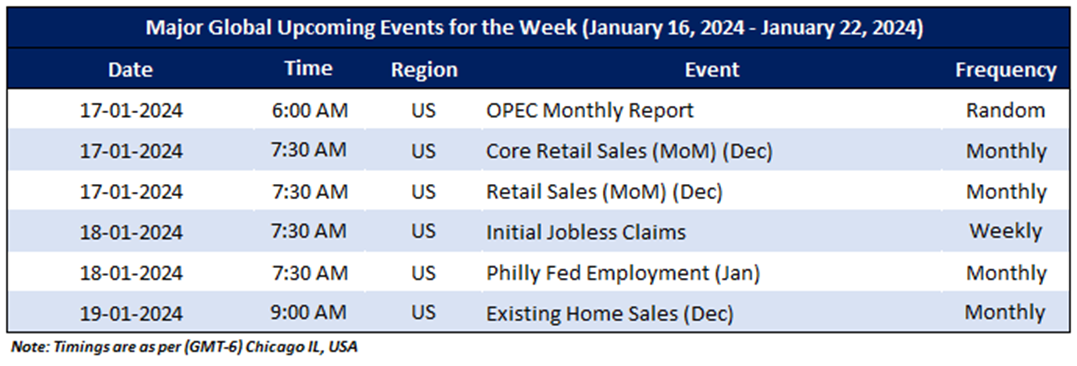0R15 8884.0068 1.4156% 0R1E 9171.0 0.0% 0M69 None None% 0R2V 255.5 0.0% 0QYR 1619.0 0.0% 0QYP 434.5 0.0% 0RUK None None% 0RYA 1606.0 4.9673% 0RIH 195.2 1.3763% 0RIH 195.2 0.0% 0R1O 225.5 9900.0% 0R1O None None% 0QFP None None% 0M2Z 255.0 0.2457% 0VSO 33.3 -6.4738% 0R1I None None% 0QZI 604.0 0.0% 0QZ0 220.0 0.0% 0NZF None None% 0YXG 246.8 2.9706%

Global Commodity Market Wrap-Up
Last week, commodities prices witnessed a mixed reaction. Profit booking in metals and a rally in energy. Gold prices recovered from weekly lows and managed to close in green and settled with a weekly gain of ~0.20% and Silver gained ~0.17% and other base metals also seen profit booking. Base metals ended in a negative gain last week, Zinc and Copper prices witnessed a weekly loss of ~1.74% and ~1.59% and Lead manages a positive close of ~0.72%.
On the Energy front, Natural Gas prices continued its rally and settled at a weekly gain of 14.52%. Moreover, profit booking in Crude Oil and prices settled with small negative of ~1.53%. Meanwhile, agricultural commodities prices also closed with a negative note, but Sugar managed to give a positive close of 2.37%.

Volume is back to normal, and most commodities are trading with a mixed to negative tone. The precious metals prices are trading in a negative direction. On the energy front we have seen a good recovery from lower levels, Corn is near to its support level and expected to give a reversal from its bearish momentum. However, Crude Oil prices are still trading in the range bound zone with slightly positive momentum. The agricultural commodities basket is trading in a negative tone also.
The upcoming Micro and Macroeconomic events that may impact market sentiments include an update on the US FOMC Meet on Rate Decision, US Core CPI data, Unemployment claim and PMI Data etc.
Having understood the global commodities performance over the past week, taking cues from major global economic events, and based on technical analysis, noted below is the recommendation with the generic insights, entry price, target prices, and stop-loss for Wheat March Future (CBOT: WH24) for the next 1-2 weeks duration:

Wheat March Future (CBOT: WH24)
Price Action and Technical Indicator Analysis:
Wheat’s March future prices witnessed a correction in recent weeks due to lower demand and now trading near its support zone, with a possibility of reversal from the current zone and can see demand to normalize. The leading indicator RSI (14-period) shows a reading of ~41.35, indicating price reversal. Further, price will try to retest its SMA line 21-period & 50-period SMAs, which may act as a resistance level.
Now the next crucial resistance levels are at USc 628 and USc 643.55, and prices may test these levels in the coming sessions (1-2 weeks).


As per the above-mentioned price action and technical indicators analysis, Wheat March Future (CBOT: WH24) is technically well-placed for a ‘Buy’ rating. Investment decisions should be made depending on an individual’s appetite for upside potential, risks, and any previous holdings. This recommendation is purely based on technical analysis, and fundamental analysis has not been considered in this report. Technical summary of the ‘Buy’ recommendation is as follows:

Upcoming Major Global Economic Events
Market events occur on a day-to-day basis depending on the frequency of the data and generally include an update on employment, inflation, GDP, WASDE report, consumer sentiments, etc. Noted below are the upcoming week's major global economic events that could impact the commodities prices:

Futures Contract Specifications

Disclaimers
Related Risks: Based on the technical analysis, the risks are defined as per risk-reward ratio (~0.80:1.00), however, returns are generated within a 1-2 weeks’ time frame. This may be looked at by Individuals with sufficient risk appetite looking for returns within short investment duration. The investment recommendations provided in this report are solely based on technical parameters, and the fundamental performance of the commodities has not been considered in the decision-making process. Other factors which could impact on the commodity prices include market risks, regulatory risks, interest rates risk, currency risks, and social and political instability risks etc.

Note 1: Past performance is not a reliable indicator of future performance.
Note 2: Individuals can consider exiting from the commodity if the Target Price mentioned as per the Technical Analysis has been achieved and subject to the factors discussed above.
Note 3: How to Read the Charts?
The Green colour line reflects the 21-period moving average while the red line indicates the 50- period moving average. SMA helps to identify existing price trend. If the prices are trading above the 21-period and 50-period moving average, then it shows prices are currently trading in a bullish trend.
The Black colour line in the chart’s lower segment reflects the Relative Strength Index (14-Period) which indicates price momentum and signals momentum in trend. A reading of 70 or above suggests overbought status while a reading of 30 or below suggests an oversold status.
The Blue colour bars in the chart’s lower segment show the volume of the commodity. Commodity with high volumes is more liquid compared to the lesser ones. Liquidity in commodity helps in easier and faster execution of the order.
The Orange colour lines are the trend lines drawn by connecting two or more price points and used for trend identification purposes. The trend line also acts as a line of support and resistance.
Technical Indicators Defined: -
Support: A level at which the stock prices tend to find support if they are falling, and a downtrend may take a pause backed by demand or buying interest. Support 1 refers to the nearby support level for the stock and if the price breaches the level, then Support 2 may act as the crucial support level for the stock.
Resistance: A level at which the stock prices tend to find resistance when they are rising, and an uptrend may take a pause due to profit booking or selling interest. Resistance 1 refers to the nearby resistance level for the stock and if the price surpasses the level, then Resistance 2 may act as the crucial resistance level for the stock.
Stop-loss: It is a level to protect further losses in case of unfavourable movement in the stock prices.
Risk Reward Ratio: The risk reward ratio is the difference between an entry point to a stop loss and profit level. This report is based on ~80% Stop Loss of the Target 1 from the entry point.
The reference date for all price data, volumes, technical indicators, support, and resistance levels is January 17, 2024 (Chicago, IL, USA 4:30 AM (GMT-6). The reference data in this report has been partly sourced from REFINITIV.
Note: Trading decisions require a thorough analysis by individuals. Technical reports, in general, chart out metrics that may be assessed by individuals before any commodity evaluation. The above are illustrative analytical factors used for evaluating the commodity; other parameters can be looked at along with additional risks per se.
References to ‘Kalkine’, ‘we’, ‘our’ and ‘us’ refer to Kalkine Limited.
This website is a service of Kalkine Limited. Kalkine Limited is a private limited company, incorporated in England and Wales with registration number 07903332. Kalkine Limited is authorised and regulated by the Financial Conduct Authority under reference number 579414.
The article has been prepared for informational purposes only and is not intended to be used as a complete source of information on any particular company. No advice or information, whether oral or written, obtained by you from Kalkine or through or from the service shall create any warranty not expressly stated. Kalkine does not intend to exclude any liability which it is not permitted to exclude under applicable law or regulation.
Kalkine does not offer financial advice based upon your personal financial situation or goals, and we shall NOT be held liable for any investment or trading losses you may incur by using the opinions expressed in our publications, market updates, news alerts and corporate profiles. Kalkine does not intend to exclude any liability which it is not permitted to exclude under applicable law or regulation. Kalkine’s non-personalised advice does not in any way endorse or recommend individuals, investment products or services for your personal financial situation. You should discuss your portfolios and the risk tolerance level appropriate for your personal financial situation, with a professional authorised financial planner and adviser. You should be aware that the value of any investment and the income from it can go down as well as up and you may not get back the amount invested.
Kalkine Media Limited, an affiliate of Kalkine Limited, may have received, or be entitled to receive, financial consideration in connection with providing information about certain entity(s) covered on its website.